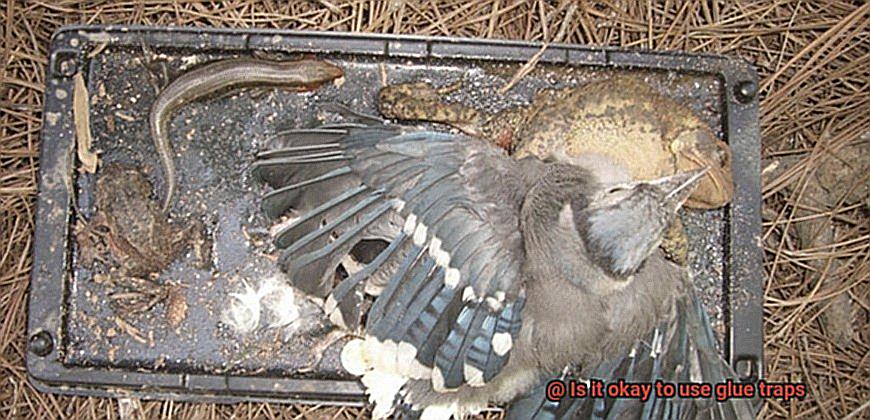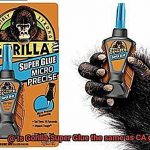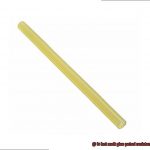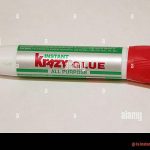In the constant battle against unwelcome pests invading our homes and businesses, a plethora of control methods have emerged. Among these options, glue traps have gained popularity due to their perceived efficiency and simplicity. However, the ethical implications, practical effectiveness, and potential dangers associated with using glue traps have ignited an ongoing debate.
Glue traps are comprised of a sticky adhesive surface mounted on a board or tray. Once a pest like mice, insects, or spiders make contact with the adhesive, they become immobilized. While some argue that these traps provide a humane way to catch and remove pests without toxic chemicals, others raise concerns about the suffering endured by trapped creatures.
Proponents of glue traps often highlight their practical effectiveness as a primary benefit. These traps can be easily placed in areas frequented by pests, ensuring a high capture rate due to their stickiness. Additionally, they serve as useful tools for monitoring pest activity and identifying specific species invading your space.
However, despite their perceived efficacy, glue traps present ethical concerns. Animal rights advocates argue that these traps subject pests to unnecessary suffering. Trapped creatures may experience prolonged distress, fear, and struggle before meeting their fate. Moreover, unintended victims such as birds or pets can inadvertently fall prey to these traps, raising further ethical dilemmas.
Furthermore, while glue traps may seem like quick and convenient solutions, they may not be practical in all situations. Large infestations can overwhelm a limited number of traps, making other pest control methods more suitable for comprehensive eradication. Additionally, if not properly placed and monitored over time, glue traps can lose their effectiveness and require frequent maintenance and replacement.
Moreover, there are potential dangers associated with glue traps that must be considered. As trapped pests struggle to free themselves from the adhesive grip, they may unintentionally chew off their own limbs in desperate attempts to escape, resulting in severe injuries. Additionally, trapped pests may release stress hormones that can transmit diseases and contaminate the surrounding area.
In conclusion, the use of glue traps for pest control sparks heated discussions and ethical dilemmas. While they offer practical effectiveness in capturing pests, their potential to cause suffering and unintended harm raises valid concerns. It is essential to carefully consider the pros and cons before deciding whether or not to use glue traps as a pest control method.
What are Glue Traps?
Contents
- 1 What are Glue Traps?
- 2 Pros and Cons of Using Glue Traps
- 3 Ethical and Humane Implications of Using Glue Traps
- 4 Potential Harm to Target Animals with Glue Traps
- 5 Unintended Targets Caught in Glue Traps
- 6 Alternatives to Glue Traps for Pest Control
- 7 Advantages of Using Glue Traps Over Other Methods
- 8 Considerations Before Choosing to Use Glue Traps
- 9 Conclusion
In the realm of pest control, the search for non-toxic alternatives to chemicals and baits has led many to discover the intriguing world of glue traps, commonly known as sticky traps. This captivating article will delve deep into the essence of glue traps, exploring their purpose, mechanics, and the heated debate surrounding their use.
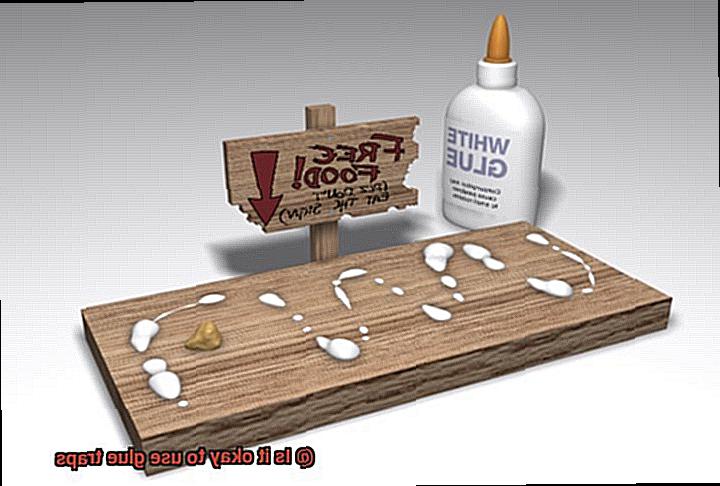
What Are Glue Traps?
Glue traps are ingeniously designed pest control devices that effectively capture and immobilize insects, rodents, and other small animals. These handy contraptions feature a flat surface coated with a powerful adhesive substance that entraps unsuspecting pests upon contact.
Offering versatility for both residential and commercial settings, glue traps excel at ensnaring various pests such as mice, rats, spiders, cockroaches, and flies.
How Do They Work?
Glue traps exploit pests’ innate curiosity, enticing them to explore their surroundings. When these unwelcome visitors encounter a glue trap, they mistake it for an innocuous surface and unwittingly become ensnared by its sticky grasp. Once trapped, their futile struggles only serve to entangle them further in the tenacious adhesive.
Benefits of Glue Traps:
- Non-toxic alternative: Glue traps provide a chemical-free method of pest control, appealing to those concerned about potential health risks.
- Versatility and accessibility: With an array of sizes and designs available, glue traps can be employed in confined spaces or sensitive environments where traditional methods may not be feasible.
- Cost-effective: Compared to other pest control methods, glue traps are relatively inexpensive and effortless to use.

Drawbacks of Glue Traps:
- Ethical concerns: Critics argue that glue traps inflict unnecessary suffering on trapped animals, who may struggle for hours or even days before meeting their unfortunate fate.
- Unintended targets: Glue traps, in their indiscriminate nature, can inadvertently ensnare unintended animals like birds or small pets, raising concerns about animal welfare.
- Limited effectiveness: While glue traps prove adept at capturing individual pests, they may not eradicate an entire infestation on their own. They are best implemented as part of an integrated pest management approach.
Addressing Concerns:
To assuage ethical concerns, certain manufacturers have developed glue traps with special release mechanisms or non-toxic adhesives, enabling trapped animals to be freed unharmed. These alternatives present a more compassionate option while still providing effective pest control.
Pros and Cons of Using Glue Traps
In this blog post, we will explore the pros and cons of using glue traps for pest control. Whether you’re a homeowner dealing with pesky rodents or a curious reader interested in alternative pest control methods, this analysis will help you make an informed decision.
Pros:
- Effectiveness: Glue traps excel at catching pests. Their sticky surfaces make it challenging for mice, rats, spiders, and insects to escape, ensuring a higher success rate compared to other trapping methods.
- Easy to Use: No need for additional tools or baits. Just place the trap in the infested area and let it work its magic. It’s a hassle-free solution for homeowners.
- Non-Toxic: Unlike chemical pest control methods, glue traps are non-toxic and safe for households with children or pets. They provide a safer option for pest control without the risk of harmful substances.
- Versatility: From rodents to crawling insects, glue traps can effectively capture a wide range of unwanted creatures, making them a versatile option for pest control.
Cons:
- Cruelty and Inhumane: The major concern surrounding glue traps is the suffering inflicted on trapped animals. Pests can struggle to free themselves, leading to prolonged suffering and even death. It raises ethical questions about the use of these traps.
- Unsanitary: Improper disposal of glue traps can become breeding grounds for bacteria and disease-causing organisms, posing health risks to humans and pets. Proper hygiene practices are essential when using these traps.
- Ineffectiveness for Some Pests: While highly effective against certain pests, nimble creatures like mice may sometimes manage to escape from the adhesive surface. This limits their effectiveness in certain situations.
- Potential for Accidental Capture: Glue traps are indiscriminate in their targets, which means there is a risk of unintentionally capturing non-target animals that can disrupt ecosystems and harm beneficial species. Careful placement is necessary to avoid unintended consequences.
- Emotional Impact: Witnessing trapped animals struggling can be distressing for some individuals, leading to feelings of guilt or remorse. The emotional impact of using glue traps should be considered.
Ethical and Humane Implications of Using Glue Traps
Glue traps, those infamous sticky traps used for pest control, have long been a subject of controversy due to their ethical and humane implications. It is crucial to delve into these concerns and consider alternative options that prioritize compassion and respect for all living beings.
First and foremost, the inhumane treatment of animals is a major ethical concern associated with glue traps. Once an animal gets ensnared in the sticky surface, they desperately struggle to break free, often causing injuries in the process. Some unfortunate creatures go to extreme lengths, even resorting to chewing off their own limbs in a desperate bid for escape. The thought of such suffering is truly heart-wrenching.
But the cruelty doesn’t end there. Glue traps subject trapped animals to a slow and agonizing death. Imagine being trapped for hours or even days, slowly succumbing to exhaustion, dehydration, or starvation. It is a cruel and unnecessary method of pest control that demands serious reconsideration.
Moreover, glue traps pose a significant risk not just to pests but also to non-target animals like our beloved pets or innocent wildlife. Our curious cats or playful dogs can easily become victims of these sticky traps, leading to distress and potential harm. Even birds or other small animals may find themselves trapped if they accidentally touch the adhesive surface.
From an ethical standpoint, it is imperative to explore alternative methods that are more humane. Catch-and-release traps offer a safe way to capture pests without causing harm. With these traps, we can relocate pests to a more suitable environment rather than subjecting them to a slow and painful demise.
Furthermore, we must consider the effectiveness of glue traps. While they may initially catch some pests, they often fail to address the root cause of infestations. This means that we may find ourselves trapped in a never-ending cycle of catching and re-infestation.
Given these ethical concerns and questioning the efficacy of glue traps, it is no surprise that some argue for their complete banishment. Several countries and states have already implemented restrictions or outright bans due to the inhumane nature of these traps.
So, next time you are faced with a pest problem, think twice before reaching for that sticky solution. Consider more ethical alternatives like professional pest control services that prioritize humane practices or try out non-lethal options like sonic deterrents or natural repellents.
Let us take a stand against cruelty and strive for effective solutions that respect all creatures, big and small. Together, we can create a world where pest control is not just about extermination but also about compassion and respect for every living being.
Potential Harm to Target Animals with Glue Traps
Imagine being a small, unsuspecting mouse, scurrying around in search of food, when suddenly you find yourself ensnared in a sticky, unforgiving mess. As you struggle desperately to break free, the adhesive clings tighter, trapping you in a nightmare scenario. This is the harsh reality for countless animals caught in glue traps. In this article, we will explore the potential harms these traps pose to target animals and shed light on why we urgently need to shift towards more humane pest control methods.
Extreme Distress and Suffering:
Once an animal becomes ensnared in a glue trap, panic ensues. The powerful adhesive immobilizes them, leaving them to endure hours or even days of desperate struggle. Their frantic attempts to escape lead to exhaustion, dehydration, and starvation. Can you imagine the sheer terror and helplessness they experience during this ordeal?
Physical Injuries:
Animals caught in glue traps often inflict harm upon themselves in their desperate bids for freedom. They may tear at their skin or fur, resulting in painful wounds and open sores that are highly susceptible to infection. The adhesive can also adhere to sensitive body parts such as eyes, nose, and mouth, causing severe discomfort and potentially leading to respiratory problems or suffocation.
Self-Mutilation:
As a last-ditch effort to escape, some animals resort to self-mutilation. They may gnaw at their own limbs or attempt to chew through the trap itself, causing severe injuries and sometimes even death. It is heart-wrenching to fathom the lengths these creatures will go to in order to liberate themselves from their sticky prison.
Long-Term Trauma:
Even if an animal survives its harrowing encounter with a glue trap, it may suffer lasting physical and psychological trauma. The experience can leave enduring effects on their overall well-being and quality of life. It serves as a haunting reminder of the price these innocent creatures pay for our convenience in pest control.
Unintended Victims:
Glue traps not only harm the intended target animals but also pose a grave threat to non-target species. Birds, lizards, and even beloved pets can inadvertently become trapped if they come into contact with these devices. The potential harm extends beyond the intended victims, further underscoring the pressing need for more humane alternatives.
Conclusion:
Unintended Targets Caught in Glue Traps
Glue traps, hailed as the ultimate solution for catching bothersome pests, hold a hidden secret – they ensnare far more than their intended targets. This article delves into the dark side of glue traps, shedding light on the ethical concerns and potential harm inflicted upon unintended victims.
The Sticky Situation:
Our beloved pets, those furry companions who bring joy to our lives, often fall prey to the treacherous clutches of glue traps. Cats and dogs innocently wander into these adhesive traps, only to find themselves entangled in a sticky nightmare. The consequences are dire, with severe injuries and unimaginable distress plaguing these innocent animals. Their desperate struggles to break free tug at our hearts.
Beyond our own homes, wildlife also becomes unwitting casualties of glue traps. Birds soar into the danger zone, squirrels scamper across the wrong path, and reptiles unknowingly venture into a trap set by human hands. These creatures, integral to the delicate balance of our ecosystems, suffer undeservedly due to our pest control methods.
Ethical Concerns:
The indiscriminate nature of glue traps raises profound ethical questions. These traps show no mercy, capturing any creature that dares cross their path. Is it morally justifiable to inflict such harm on unintended victims in our relentless pursuit of pest control? The answer is a resounding no.
Considering Alternatives:
To mitigate the harm caused to unintended targets, it is imperative that we explore alternatives to glue traps. Catch-and-release traps offer a compassionate solution, allowing for the safe capture and release of pests outside our homes or businesses. Natural deterrents, such as essential oils or ultrasonic devices, present effective alternatives that ward off pests without inflicting harm.
Alternatives to Glue Traps for Pest Control
Glue traps have long been the go-to solution for pest control, but their harmful effects on animals and ethical concerns have prompted the search for alternative methods. In this blog post, we will explore three humane alternatives to glue traps that effectively control pests without causing unnecessary suffering.
Mechanical Traps – Snap Traps:
Snap traps swiftly and humanely kill rodents by snapping shut when triggered, ending their lives instantly.
Advantages:
- Quick and effective in capturing and eliminating rodents.
- Easy to set up and dispose of.
Disadvantages:
- Requires regular checking and resetting.
- May not be suitable for larger rodents like rats.
- Requires caution to avoid accidental injury.
Live Traps:
Overview: Live traps capture pests without harm, typically consisting of a cage or box with a door that closes behind the animal once it enters. The captured pest can then be released in a more suitable location away from your property.
Advantages:
- Humane approach for safe pest removal.
- Can be reused multiple times.
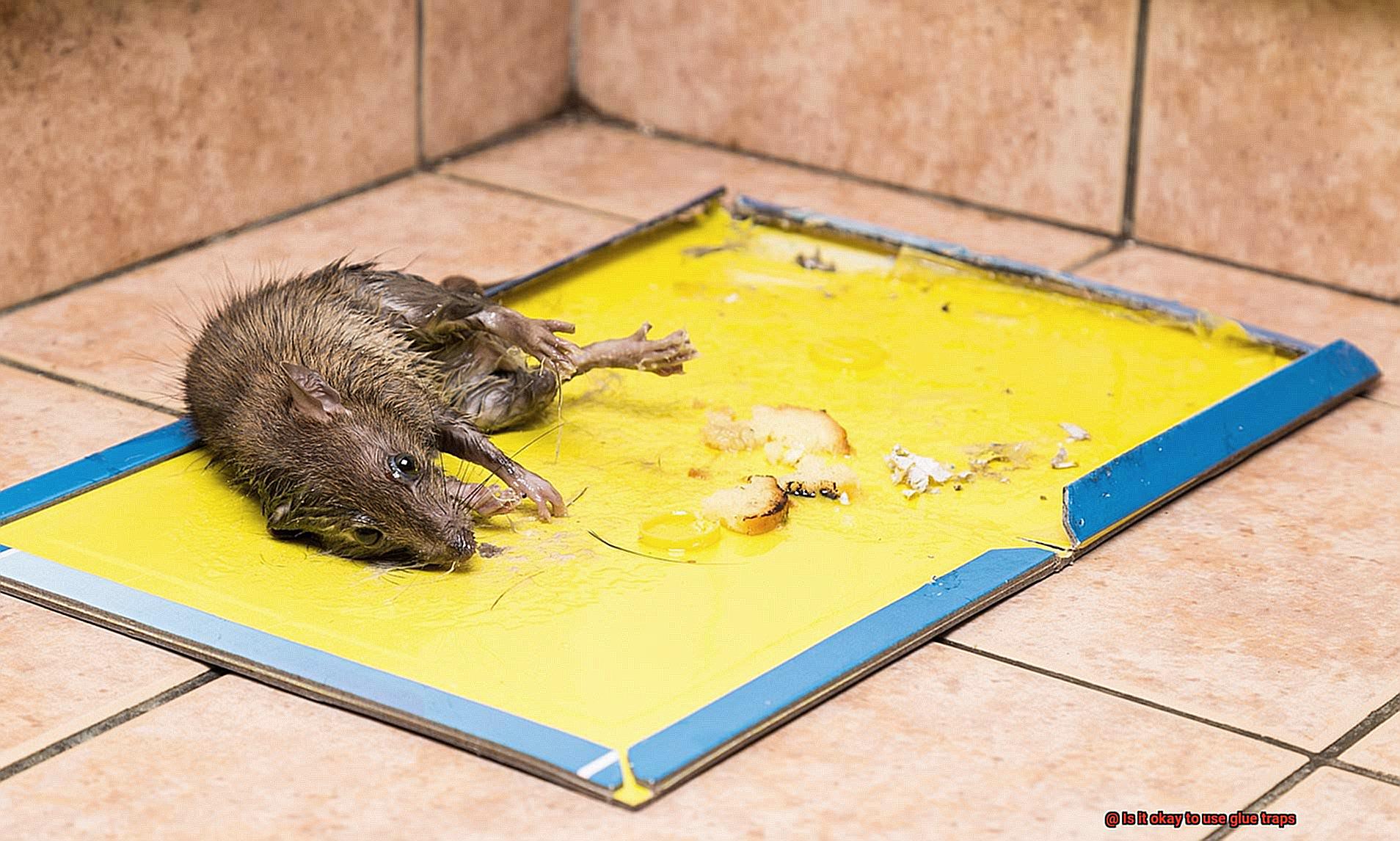
Disadvantages:
- Requires regular monitoring for timely release.
- May not be as effective for certain pest species.
- Improper relocation may release pests near other properties.
Electronic Traps:
Overview: Electronic traps use bait to attract pests and deliver a quick, painless electric shock once they enter. This method ensures swift and humane elimination of pests.

Advantages:
- Swift and humane pest elimination.
- Safe for indoor use without toxic chemicals.
Disadvantages:
- Requires proper placement and bait selection for effectiveness.
- May require batteries or a power source.
- More expensive than traditional glue traps.
Advantages of Using Glue Traps Over Other Methods
Look no further than glue traps to put an end to your pest control woes. Glue traps offer a plethora of advantages over other methods, making them a top choice for countless individuals. Let’s delve into these advantages in greater detail.
First and foremost, glue traps boast unparalleled effectiveness in catching and ensnaring a vast array of pests. Whether you’re grappling with insects, rodents, or even small animals, the sticky surface of the trap ensures that once they come into contact with it, escape is futile. This makes glue traps especially valuable in situations where alternative methods have failed to effectively control the pest population.
One major advantage of glue traps is their superior safety compared to other pest control methods. Chemical pesticides or rodenticides can pose a poisoning risk to humans and pets if not used with utmost caution. On the other hand, glue traps are non-toxic and emit no harmful fumes or chemicals into the environment. This renders them a safer option for households with children and pets.
In addition to being safe, glue traps are incredibly user-friendly. Most traps come pre-baited with attractants that entice pests onto the sticky surface. All you need to do is strategically place the trap in areas frequented by pests, such as along walls or near entry points. Once pests are captured, disposal is a breeze without any elaborate cleanup process.
Glue traps serve not only as a means of control but also as a monitoring tool. By strategically positioning traps around your property, it becomes easier to identify the type and extent of pest infestations. The trapped pests can be examined for species identification, aiding in determining the most suitable course of action for effective pest management.
Another advantage of glue traps is their versatility. They can be utilized in various settings, including residential homes, commercial buildings, warehouses, and even the great outdoors. They can be placed on floors, walls, or mounted on boards, depending on the target pests and the area being treated. This versatility makes them suitable for a wide range of pest control needs.
If you’re concerned about the financial implications of pest control, glue traps offer an economical solution. They are generally more affordable than hiring professional pest control services or investing in elaborate pest control equipment. Moreover, glue traps can be purchased in bulk, further reducing their cost per unit.
Lastly, glue traps are environmentally friendly compared to chemical alternatives. They do not involve the use of harmful chemicals or pesticides, which means they do not contribute to air or water pollution. Additionally, glue traps can be disposed of in regular trash without any negative impact on the environment.
Considerations Before Choosing to Use Glue Traps
When it comes to pest control, there are numerous options available, and one popular choice is the use of glue traps. However, before hastily purchasing a pack of these sticky devices, it is crucial to take into account several important considerations.
First and foremost, let’s address the ethical implications of using glue traps. While they may be effective in capturing pests, they can also cause prolonged suffering for trapped animals. Just imagine being stuck in adhesive, unable to move or escape for hours or even days. This raises questions about the humane treatment of pests and whether there are more compassionate alternatives available.
In addition to ethical concerns, effectiveness is another factor that should be carefully considered. Glue traps can indeed catch pests, but they fail to address the underlying cause of the infestation. For instance, let’s say you have mice in your home – catching them with glue traps does not solve the fundamental issue of how they gained entry or how to prevent future infestations.
Furthermore, glue traps can pose a significant risk to non-target animals and pets. If a curious cat or a wildlife creature comes into contact with a glue trap, they can become ensnared and experience unnecessary distress. This can lead to injuries as animals desperately attempt to free themselves, potentially causing harm or even death.
Disposing of glue traps can also present challenges. Once a pest is caught on a glue trap, it may still be alive and struggling. Removing the trapped animal without causing further harm can be incredibly difficult, and simply discarding the trap with a live animal still stuck on it is both cruel and unsanitary.
Legal and regulatory issues should not be overlooked either. Some jurisdictions have either banned or restricted the use of glue traps due to concerns over animal cruelty. It is crucial to familiarize oneself with local laws and regulations before making the decision to use glue traps.
Finally, before resorting to glue traps, it is essential to explore alternative pest control methods. Integrated Pest Management (IPM) techniques prioritize prevention rather than relying solely on trapping devices. These methods, such as sealing entry points and removing food sources, have proven to be more effective in controlling pests and do not pose harm to animals.
9-Xu8PNvkKA” >
Conclusion
In conclusion, the use of glue traps raises ethical concerns and should be reconsidered. These traps may seem like a convenient solution for pest control, but they come with significant drawbacks. Glue traps are inhumane, causing unnecessary suffering to animals that become trapped in them. The prolonged struggle and stress experienced by these creatures is distressing to witness. Furthermore, glue traps do not discriminate between pests and beneficial wildlife, leading to unintended harm to non-target species such as birds or lizards.
It is important to remember that there are alternative methods available for pest control that are more humane and effective. Integrated Pest Management (IPM) techniques focus on prevention and long-term solutions rather than relying solely on trapping or killing pests. This approach involves identifying the root causes of infestations and implementing strategies like sealing entry points, removing food sources, and using natural repellents.
By embracing IPM practices, we can strike a balance between managing pests and respecting the well-being of all creatures. It is our responsibility as stewards of the environment to prioritize compassion over convenience when it comes to dealing with unwanted visitors in our homes or businesses.
Let us move towards a future where we choose kindness over cruelty, adopting methods that promote coexistence rather than causing harm.

